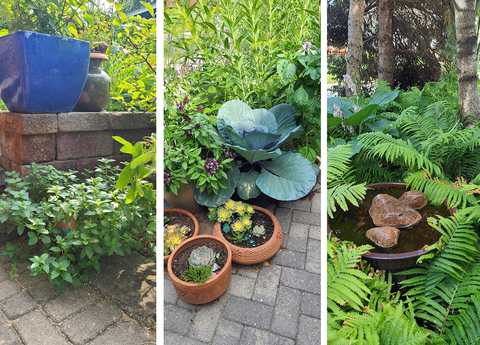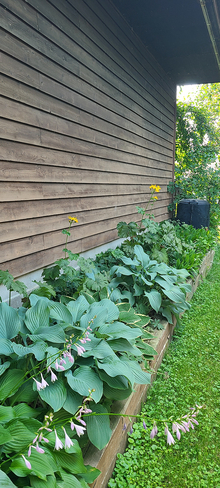what to plant in shady backyard in northern virginia
Quick facts
- Shady areas are cooler and the soil remains moist longer.
- Shady areas may be the last areas in your landscape to thaw out in the winter.
- Different levels of shade exist, from dappled to deep shade.
- Soil fertility can be a challenge to maintain and plants frequently require supplemental fertilization.
- Containers of plants can be located under trees and near shrubs to avoid competition from tree and shrub roots.
Variety in landscape lighting tin can add together interest and a sense of discovery to your m and garden. This includes a multifariousness of plants, the use of structures and containers, and having various levels of light from full sun to full and even deep shade. Created past copse, landscape light allows you to exist artistic in various parts of your yard and garden.
Trees are valuable additions to landscapes.
- They provide shade and windbreaks resulting in free energy efficiency.
- Trees lower ambience temperatures by creating shade and through transpiration.
- Trees provide habitat for wild fauna, supporting many forms of life, and they absorb carbon dioxide, converting it through photosynthesis into oxygen.
- Healthy trees tin can raise belongings values by 3 to xv%.
See The Benefits of Copse from the National Arbor Foundation.
The National Tree Benefit Reckoner can assist you estimate the value your trees provide to your mural and neighborhood.
Creating shade
You can create shade by locating structures like pergolas and layering taller perennials and climbing plants so they block dominicus from other plants, shading them.
You can also tuck low-growing plants under other plants, creating a shady growing environment. A large Sagae Hosta provides shade for big root geraniums.
Planning a shade garden
Know your site atmospheric condition
Creating shade gardens tin be a challenge, simply i that, equally gardeners facing warmer, drier summers, we should embrace in lodge to have a long-lived, healthy landscape. The kickoff step is to empathize your growing conditions:
- Size of your planting space
- Common cold hardiness zone
- Light levels
- Soil atmospheric condition
Having a basic cognition of the garden area will help yous choose the plants that will grow best in your site and your plants will thrive, not only survive. A plant won't perform well in conditions that differ from what it needs to grow. The establish will be stressed and unable to reach its full size, class and shape, nor volition information technology produce healthy leaves and flowers. Plants growing in less-than-optimal conditions are also more than likely to succumb to diseases and insect damage.
"Right Found, Right Place" establish selection video series
|
Maybe it'south but room for a few plants under a shade tree. Or a large woodland garden. Either way, measure the plantable space and keep that in mind when selecting your plants. Plants should accept enough room to grow to their total, mature size.
Bank check plant labels, catalogs or the Found Elements of Design plant database for specific plant information. All the plants in the following lists include the mature size of the plant.
Existence "zone hardy" means a plant tin can survive the temperature extremes in a particular area. For the nearly reliably hardy plants:
- Detect your hardiness zone.
- A plant'south cold hardiness data can be found on plant labels, in catalogs, reference books, databases and on reputable websites.
- Choose plants listed for your hardiness zone.
- If yous decide to effort growing a found from a warmer hardiness zone such as zone 5 or 6, have realistic expectations that this constitute may not live through the winter.
Shady areas are microclimates or areas within your landscape where the weather condition (air current, light, moisture, temperature) vary from the surrounding landscape. Some common microclimates:
- Evergreen trees and shrub plantings provide twelvemonth-round shade and create a cooler space that is protected from the wind.
- Areas where soil remains consistently moist and may thaw final in your landscape due to less sunlight and cooler temperatures,
- Areas where soil remains consistently dry due to protection from rain by structures, overhangs, etc.
- Areas where the ambient temperature is higher due to intense sunlight and lack of cooling winds.
- Areas where the ambient temperature is lower due to shade from trees.
Spend fourth dimension observing the light levels in your landscape and how they alter throughout the 24-hour interval and seasons. Put a thermometer in different areas of your landscape and find the changes as the sun moves through the heaven. For example, morning sunday is less intense and thus provides full sun atmospheric condition without extreme heat whereas afternoon sunday is stronger and temperatures warmer.
Light levels of shade:
- Dappled shade: light filtering through a tree canopy
- Calorie-free shade or role shade: about 3-6 hours of sunlight
- Full shade: less than iii hours of sunlight
- Deep shade: almost no sunlight
Although areas with part shade receive straight sunlight for a small portion of the twenty-four hours, the light intensity can still be quite bright.
- In that location are numerous plants that abound in part shade such as woodland wildflowers.
- Sure herbs and leafy greens can exist grown in dappled to part shade conditions.
- Some plants tolerate relatively low light levels and a few actually thrive.
- Many groundcovers practise well in shady areas.
Soil affects everything yous do from planting flowers and copse to growing a healthy lawn to edifice structures like decks, patios and terraces. For plants, information technology supplies plants with nutrients, water, microbes and air for the healthy growth of roots, and provides a means of support to go along plants firmly rooted in the ground.
A solid agreement of the soil on your property is primal to knowing which plants volition grow well in your landscape. A soil test is a skillful identify to start and the most reliable way to get together specific data:
- Exam your soil every 3-v years at the UMN Soil Testing Lab.
- Test your soil when y'all convert an surface area of your landscape to something new such as backyard to a vegetable garden.
- Soil can vary throughout a landscape, especially on urban sites, due to construction, soil amendments, erosion, etc.
Shade gardens typically retain soil wet due to cooler temperatures and protection from sunlight. This tin benefit plants that prefer cool, consistently moist growing conditions. Nevertheless, this means a shade garden may warm upward afterward in the leap. Moss and slugs may besides be problematic in shade gardens.
Slugs in abode gardens
Every bit a microclimate, dry out shade is one of the most limiting for gardeners and found lovers. Dry shade is created by:
- Tree canopies.
- Eaves and overhangs of a house.
- Competition from other plants for light and soil wet.
- Building foundations and structures that cake rainfall.
Growing plants beneath big trees or nether the overhang of a building is challenging because they prevent even plentiful rainfall from reaching the plants. The dry soil and lack of sunlight create difficult growing atmospheric condition for plants.
Selecting plants that abound in dry shade will help reduce (but not totally eliminate) supplemental watering. Supplemental watering will be needed occasionally in dry shade plantings. Use a drip hose, irrigation or hand h2o to saturate the elevation three to 4 inches of soil when it'south dry.
Most shade plants grow well in moist, well-tuckered organic soil. Still, acceptable nutrients maintaining soil fertility can be challenging in shady sites.
- Copse and some shrubs take extensive root systems or "feeder roots" in the top 18 to 20 inches of soil that compete with other plants for infinite, nutrients and water.
- Examination your soil to better sympathize how to improve your soil especially if plants have special soil requirements such as acidic soil pH.
- Equally a general recommendation, use a balanced fertilizer such as a xv-15-15 (N-P-Yard) in jump followed by 1 or two applications as the flavor progresses.
Containers and houseplants in shade gardens
Containers add interesting art and construction to your shade garden. Stretch your creativity by mixing and matching annuals, perennials, bulbs, and even some edibles in your garden beds and containers.
- Start with robust bedding plants from your local nursery or garden center. Don't bother direct seeding shade annuals as our season is besides brusque for most to e'er bloom well.
- Get creative! Combine annuals, bulbs, grasses, small-scale shrubs and perennials in containers.
- Fix containers nether trees and near shrubs to avert combating tree and shrub roots.
- If space allows, sink pots into the soil to conserve moisture.
- Tall shrubs tin can provide shade for houseplants in pots
- Replant containers each spring equally these plants volition most likely not survive the winter in containers.
Houseplants equally function of a shade garden
Await for unusual items that can be reused equally planting containers—pails, troughs, cans, wagons, ceramic crocks. Just almost anything can hold a plant. Utilise a power drill to add together drainage holes in almost materials. If drainage holes are not possible, pot up your establish in a separate pot and set it in the container. Remove it from the outer container when you h2o and allow it to drain well earlier putting information technology back.
Incorporating your houseplants into shade gardens can add some exotic interest to your garden.
Many houseplants also benefit from beingness outdoors over the summertime. However, a modify in location tin daze a establish, so it'southward of import to gradually become plants accustomed to new growing conditions or acclimate them.
- Locate houseplants in dappled shade and under trees to protect them from the hot midday sun.
- Hang plants from tree branches or from structures like a pergola.
- Add lighting to highlight plants and create a great gathering space for summertime evenings.
- Accept advantage of shaded patios and due north sides of your house to hang plants on walls.
Deciduous shrubs that abound well in shade
Evergreens for shade
Small deciduous trees for shade
Tall perennials for shade
Ground covers for shade
Reviewed in 2021
sullivanhasky1985.blogspot.com
Source: https://extension.umn.edu/planting-and-growing-guides/gardening-shade





0 Response to "what to plant in shady backyard in northern virginia"
Post a Comment